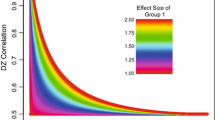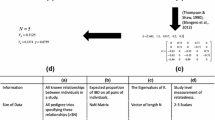Abstract
There is evidence in different species of genetic control of environmental variation, independent of scale effects. The statistical power to detect genetic control of environmental or phenotypic variability for a quantitative trait was investigated analytically using a monozygotic (MZ) twin difference design and a design using unrelated individuals. The model assumed multiplicative or additive effects of alleles on trait variance at a bi-allelic locus and an additive (regression) model for statistical analysis. If genetic control acts on phenotypic variance then the design using unrelated individuals is more efficient but 10,000s of observations are needed to detect loci explaining at most 3.5% of the variance of the variance at genome-wide significance. If genetic control acts purely on environmental variation then an MZ twin difference design is more efficient when the MZ trait correlation is larger than ~0.3. For a locus that explains a given proportion of the variation in variance, twice the number of observations is needed for detection when compared to a locus that explains the same proportion of variation in phenotypes.


Similar content being viewed by others
References
Benyamin B, Deary IJ, Visscher PM (2006) Precision and bias of a normal finite mixture distribution model to analyze twin data when zygosity is unknown: simulations and application to IQ phenotypes on a large sample of twin pairs. Behav Genet 36(6):935–946
Bull JJ (1987) Evolution of phenotypic variance. Evolution 41(2):303–315
De Jong G, Bijma P (2002) Selection and phenotypic plasticity in evolutionary biology and animal breeding. Livest Prod Sci 78:195–214
Dickerson GE (1962) Implications of genetic-environmental interaction in animal breeding. Anim Prod 4:47–63
Dunne MP, Martin NG, Statham DJ, Slutske WS, Dinwiddie SH, Bucholz KK, Madden PA, Heath AC (1997) Genetic and environmental contributions to variance in age at first sexual intercourse. Psychol Sci 8:211–216
Eaves LJ, Last KA, Martin NG, Jinks JL (1977) A progressive approach to non-additivity and genotype-environmental covariance in the analysis of human differences. Brit J Math Stat Psychol 30:142
Falconer DS (1990) Selection in different environments: effects on environmental sensitivity (reaction norm) and on mean performance. Genet Res 56:57–70
Gibson G, Wagner G (2000) Canalization in evolutionary genetics: a stabilizing theory? Bioessays 22(4):372–380
Haseman JK, Elston RC (1972) The investigation of linkage between a quantitative trait and a marker locus. Behav Genet 2(1):3–19
Heath AC, Jardine R, Martin NG (1989) Interactive effects of genotype and social environment on alcohol consumption in female twins. J Stud Alcohol 50(1):38–48
Hill WG (2004) Heterogeneity of genetic and environmental variance of quantitative traits. J Ind Soc Agric Stat 57:49–63
Jinks JL, Connolly V (1973) Selection for specific and general response to environmental differences. Heredity 30:33–40
Lynch M, Walsh B (1998) Genetics and analysis of quantitative traits. Sinauer Associates, Sunderland, MA
Mackay TF, Lyman RF (2005) Drosophila bristles and the nature of quantitative genetic variation. Philos Trans R Soc Lond B Biol Sci 360(1459):1513–1527
Martin NG, Rowell DM, Whitfield JB (1983) Do the MN and Jk systems influence environmental variability in serum lipid levels? Clin Genet 24(1):1–14
Martin NG, Clark P, Ofulue AF, Eaves LJ, Corey LA, Nance WE (1987) Does the PI polymorphism alone control alpha-I-antitrypsin expression? Am J Hum Genet 40:267–277
Ordas B, Malvar RA, Hill WG (2008) Genetic variation and quantitative trait loci associated with developmental stability and the environmental correlation between traits in maize. Genet Res 90(5):385–395
Ros M, Sorensen D, Waagepetersen R, Dupont-Nivet M, SanCristobal M, Bonnet JC, Mallard J (2004) Evidence for genetic control of adult weight plasticity in the snail Helix aspersa. Genetics 168(4):2089–2097
Slatkin M, Lande R (1976) Niche width in a fluctuating environment-density dependent model. Am Nat 110:31–55
Sorensen D, Waagepetersen R (2003) Normal linear models with genetically structured residual variance heterogeneity: a case study. Genet Res 82(3):207–222
Turkheimer E, Haley A, Waldron M, D’Onofrio B, Gottesman II (2003) Socioeconomic status modifies heritability of IQ in young children. Psychol Sci 14(6):623–628
Wolc A, White IM, Avendano S, Hill WG (2009) Genetic variability in residual variation of body weight and conformation scores in broiler chickens. Poult Sci 88(6):1156–1161
Wray NR, Goddard ME, Visscher PM (2007) Prediction of individual genetic risk to disease from genome-wide association studies. Genome Res 17(10):1520–1528
Wray NR, Coventry WL, James MR, Montgomery GW, Eaves LJ, Martin NG (2008) Use of monozygotic twins to investigate the relationship between 5HTTLPR genotype, depression and stressful life events: an application of item response theory. In: Genetic effects on environmental vulnerability to disease. Wiley, Chicheste, pp 48–67
Zhang XS, Hill WG (2005) Evolution of the environmental component of the phenotypic variance: stabilizing selection in changing environments and the cost of homogeneity. Evolution 59(6):1237–1244
Zhang XS, Hill WG (2007) Competition can maintain genetic but not environmental variance in the presence of stabilizing selection. Evolution 61(7):1532–1545
Zhang XS, Hill WG (2008) Mutation-selection balance for environmental variance. Am Nat 171(3):394–399
Acknowledgments
Collaboration between D.P. and P.M.V. was supported through a Visiting Professorship grant from the Royal Netherlands Academy of Arts and Sciences (KNAW). P.M.V. is supported by the Australian National Health and Medical Research Council and D.P is supported by the Netherlands Organization for Scientific Research MaGW VIDI-452-05-318. We thank Bill Hill and Nick Martin for discussion.
Author information
Authors and Affiliations
Corresponding author
Additional information
Edited by Stacey Cherny.
Appendix: Additive model
Appendix: Additive model
The model is summarised in Table 2. Phenotypic variances (= E(y − μ)2) of the 3 genotypes are (1 + xδ), with x = 0, 1, 2. Expectations of the fourth moments are 3(1 + xδ)2.
The phenotypic variance in the population is 1 + 2pδ and the covariance between x and (y − μ)2 is hδ. The variance of (y − μ)2 is,
when δ is small. The regression R2 is therefore,
As expected, the additive and multiplicative model are similar when δ is small because 1 + 2δ ≈ (1 + δ)2 = λ2.
See Table 2.
Rights and permissions
About this article
Cite this article
Visscher, P.M., Posthuma, D. Statistical Power to Detect Genetic Loci Affecting Environmental Sensitivity. Behav Genet 40, 728–733 (2010). https://doi.org/10.1007/s10519-010-9362-0
Received:
Accepted:
Published:
Issue Date:
DOI: https://doi.org/10.1007/s10519-010-9362-0




